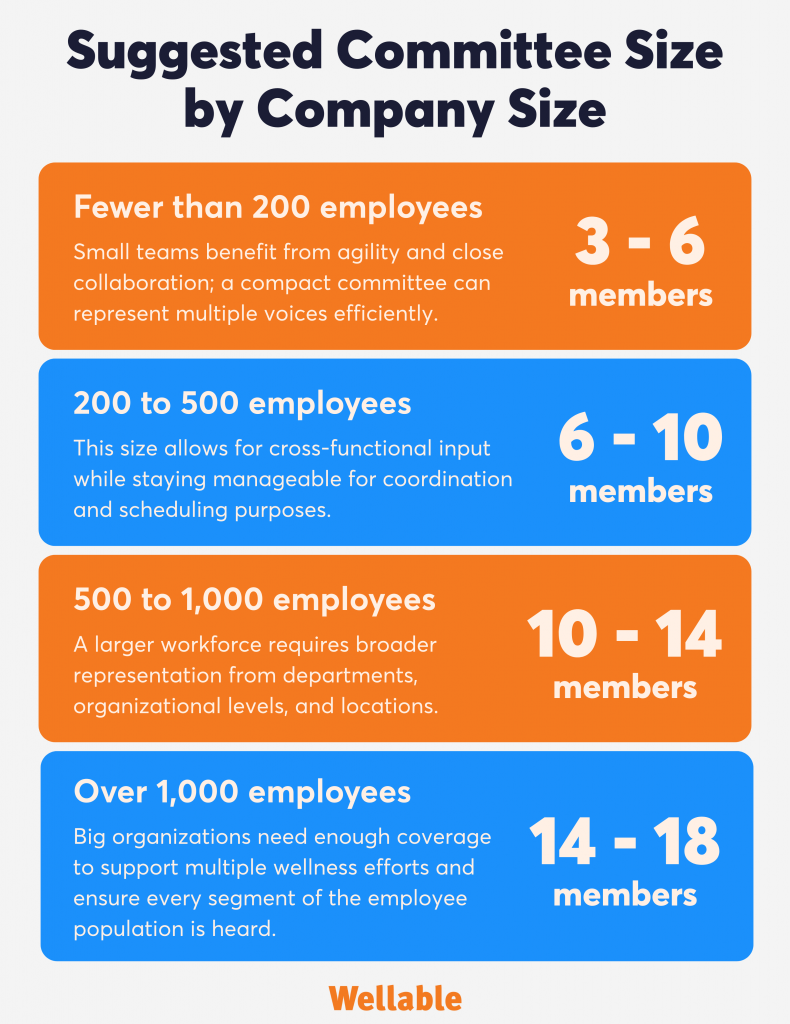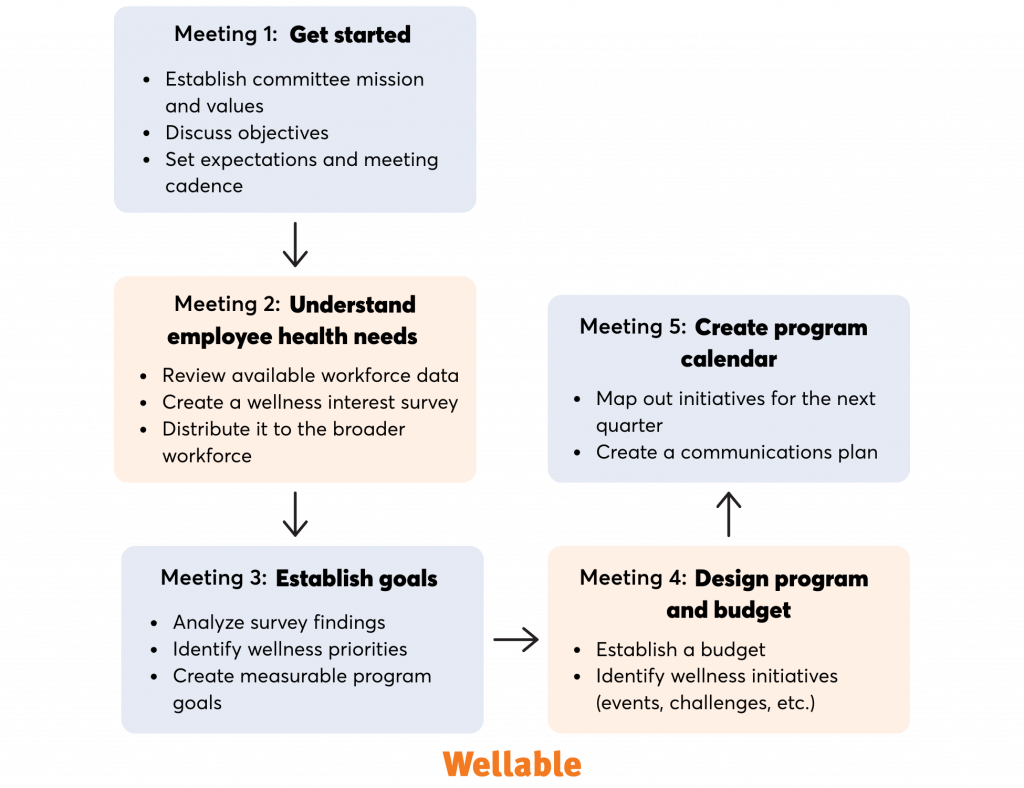Short on time? Here are the key takeaways:
- Employee participation remains a top wellness program barrier for most employers.
- A wellness committee provides structure and momentum to wellness initiatives, enhancing participation and impact.
- Wellness committees strengthen programming by organizing events, promoting resources, and embedding wellness into company culture.
- Steps to building an effective committee include securing leadership support, assembling a diverse team, defining roles, and launching with a clear mission.
- Best practices for long-term success include regular communication, inclusive collaboration, strong partnerships, and ongoing evaluation.
One of the biggest barriers to workplace well-being is low engagement, with 70% of employers citing limited participation as the top challenge to successful wellness programs. While more than half (54%) of organizations have a wellness program or strategy, many still struggle to bring these efforts to life in a way that meaningfully impacts employees’ health and well-being.
A dedicated wellness committee can serve as the driving force behind wellness program success by improving communication, establishing relevant incentives, and cultivating a stronger, more sustainable culture of wellness.
What is an Employee Wellness Committee?
A wellness committee is a group of employees dedicated to promoting health and wellness initiatives within the workplace. Their primary objectives are to identify health needs, plan and implement wellness initiatives, and foster an environment that supports healthy behaviors. Committees are often made up of employees who volunteer their time and represent various departments; in some cases, they are led by a Human Resources (HR) representative whose role involves planning and managing wellness programs. Wellness committees act as a bridge between employees and leadership, advocating for programs that reflect workforce needs and support all dimensions of well-being, from physical to financial wellness and more.

What Does a Wellness Committee Do?
Wellness committees take on a wide range of responsibilities that help engage employees and embed wellness into everyday work life. Below are examples of how a dedicated team can enhance well-being in the workplace:
- Plan wellness-related events, such as on-site or virtual fitness classes, guided meditations, or healthy cooking demonstrations.
- Run wellness challenges involving activities like counting steps, reaching hydration goals, practicing meditation, or tracking sleep.
- Implement wellness rewards or recognition programs to encourage and sustain participation.
- Organize mental health awareness campaigns and promote available Employee Assistance Program (EAP) resources.
- Host financial wellness webinars on budgeting, retirement planning, or student loan management.
- Coordinate volunteer days or community service projects to support social wellness and workplace purpose.
- Plan lunch-and-learns or educational presentations to promote professional development and continual learning.
- Share monthly wellness newsletters with health tips, resources, and upcoming activities.
- Develop and promote wellness-related policies, such as walking meetings, flexible schedules, or mental health days.
- Foster inclusive wellness by ensuring offerings accommodate diverse needs, cultures, abilities, and working arrangements.
- Partner with wellness vendors to enhance programming and ensure consistent, effective implementation.
Benefits of Implementing a Wellness Committee
A wellness committee adds structure, strategy, and staying power to your organization’s wellness efforts, providing the following benefits:
- Enhanced employee engagement: According to research, when companies offer wellness programs, 89% of employees report being engaged and happy at work. This fuels satisfaction and drives better performance.
- Improved health outcomes: A wellness committee fosters continuous development and evolution of wellness offerings by regularly introducing new activities, initiatives, and resources. This encourages sustained participation and supports the adoption of healthy habits over time.
- Strengthened workplace culture: Beyond one-off events or isolated initiatives, a wellness committee cultivates a deeper culture of well-being by embedding wellness into daily workplace practices, improving morale and productivity.
- Increased program visibility: As a bridge between employees and leadership, the committee surfaces valuable feedback, emerging needs, and success stories. This helps decision-makers understand what’s working, where improvements are needed, and how wellness programs impact employee well-being and business performance.
- Optimized budgeting and resource allocation: With a dedicated group tracking engagement and evaluating program effectiveness, organizations gain clear insights into how wellness dollars are spent. This empowers leaders to allocate budgets strategically, focusing on initiatives that resonate with employees and deliver measurable outcomes.
- Boosted business performance: Healthy, engaged employees are more productive and motivated, as well as less likely to take sick days. This leads to improved morale, team connections, retention, performance, and organizational resilience.
5 Steps to Establish an Employee Wellness Committee
1. Secure Leadership Support
Start by identifying a sponsor from senior leadership who can support the committee by allocating necessary resources and advocating for a wellness program budget. Leadership buy-in legitimizes the committee’s work and helps wellness programs stay aligned with broader company goals. HR professionals and department heads should also be brought in early to provide insight and support.
2. Build a Diverse Team
Assemble a committee that reflects the makeup of your workforce by including individuals from different departments, job types (e.g., salaried/hourly, full time/part time), and seniority levels. Try to engage people who are excited to influence workplace culture, regardless of their job title. Passion for wellness is a plus, but don’t overlook skeptics, as they offer valuable insight into how to engage employees who aren’t naturally wellness minded.

3. Define Roles, Structure, and Commitment
Set clear expectations from the start by assigning roles, such as a chairperson to lead meetings, a communications lead to manage messaging, and coordinators for wellness events and logistics. Ask members for a minimum commitment (ideally six months to a year) to promote continuity. Communicate that involvement is a professional development opportunity and part of the broader organizational strategy.
4. Secure Managerial Buy-In
Before formally creating the wellness committee, ensure each member’s manager supports their involvement. This helps avoid future scheduling conflicts and communicates that wellness is supported at every level. Empower managers to nominate team members or encourage volunteers who can balance participation with their core responsibilities.
5. Hold a Kickoff Meeting
Begin with a kickoff meeting to establish your committee’s foundation and mission. Discuss responsibilities, objectives, and expectations for collaboration and communication. Establish regular meeting times and review available resources, including budget, time, and internal support.

4 Employee Wellness Committee Best Practices
1. Communicate Regularly
Use a mix of communication methods, such as messaging tools, email, the company intranet, a wellness platform, or physical bulletin boards, to promote upcoming initiatives, share success stories, and communicate any program updates.
2. Cultivate Collaboration
Encourage active involvement from all committee members by inviting input, rotating leadership roles, and collaborating on initiatives. Ensure each member has ownership over specific tasks or projects to build trust and buy-in. To engage those who may be less comfortable speaking up in group settings, consider collecting input using regular surveys or shared documents that encourage participation and surface diverse ideas.
3. Build Strong Partnerships
Form relationships with internal stakeholders, such as other committees or highly engaged departments, to gain insights and broaden the program’s impact. Additionally, the committee can partner with experienced external vendors like wellness consultants, mental health organizations, or employee wellness companies to bring in fresh programming, expert facilitation, and new perspectives.
By outsourcing wellness events or initiatives, wellness committees can reduce the burden on internal members, helping to prevent burnout and maintain enthusiasm over time. These partnerships expand your program’s offerings, bringing wellness expertise and structure that keep employees engaged and the committee energized.
4. Continually Evaluate the Program
Regularly analyze participation rates, engagement metrics, and health outcomes, and collect employee feedback through surveys or focus groups. This allows the committee to assess the program’s effectiveness and make data-informed adjustments to initiative types, incentive structures, communication methods, and scheduling.













